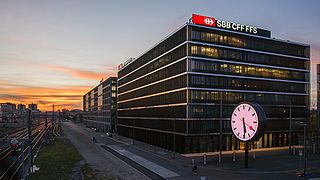
Swiss Federal Railways is the national railway company of Switzerland.
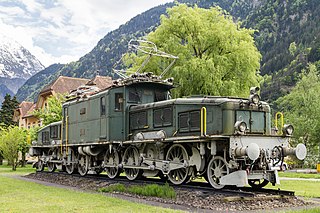
Crocodile electric locomotives are so called because they have long "noses" at each end, reminiscent of the snout of a crocodile. These contain the motors and drive axles, and are connected by an articulated center section. The center section usually contains the crew compartments, pantographs and transformer.
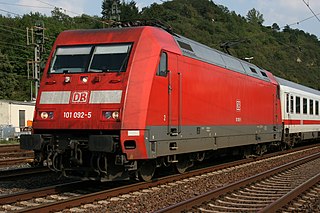
The DB Class 101 is a class of three-phase electric locomotives built by Adtranz and operated by DB Fernverkehr in Germany. 145 locomotives were built between 1996 and 1999 to replace the 30-year-old and aging Class 103 as the flagship of the Deutsche Bahn, primarily hauling Intercity services. This class encompasses the latest generation of locomotives of the Deutsche Bahn.

Alstom Traxx is a modular product platform of mainline diesel-electric and electric locomotives. It was produced originally by Bombardier Transportation and later Alstom, and was built in both freight and passenger variants. The first version was a dual-voltage AC locomotive built for German railways from the year 2000. Later types included DC versions, as well as quadruple-voltage machines, able to operate on most European electrification schemes: 1.5/3.0 kV DC and 15/25 kV AC. The family was expanded in 2006 to include diesel-powered versions. Elements common to all variants include steel bodyshells, two bogies with two powered axles each, three-phase asynchronous induction motors, cooling exhausts on the roof edges, and wheel disc brakes.

The Re 620, Re 6/6 in the old numbering scheme, are six-axle, electric locomotives of the SBB-CFF-FFS, which were acquired as a replacement for the Ae 6/6 for heavy services on the Gotthardbahn. They are the most modern of the so-called "Gotthard locomotives".
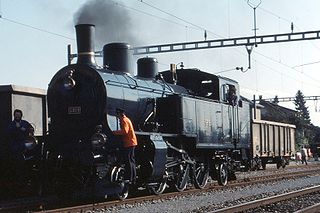
For more than a century, the Swiss locomotive, multiple unit, motor coach and railcar classification system, in either its original or updated forms, has been used to name and classify the rolling stock operated on the railways of Switzerland. It started out as a uniform system for the classification and naming of all rolling stock, powered and unpowered, but had been replaced and amended by the UIC classification of goods wagons.
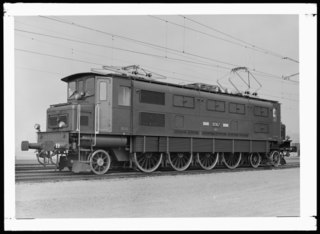
The Ae 4/7 was a universal locomotive of the Swiss Federal Railways, employing the so-called Buchli drive.
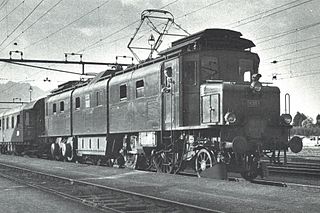
The Ae 4/8 was a prototype locomotive of the Schweizerischen Bundesbahnen (SBB) for the testing of electrical operation. The locomotive was equipped with two different drives, therefore acquiring the nickname Bastard. Because of its three-part locomotive body it also acquired the nickname Tatzelwurm.
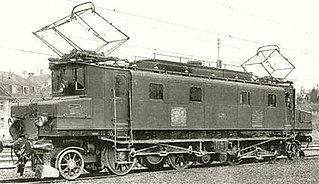
The Be 4/6 12301 was one of four test locomotives ordered by the Schweizerische Bundesbahnen (SBB) in June 1917. For gaining experience for ordering electrical locomotives this locomotive should – as her three sisters Be 3/5 12201, Be 4/6 12302 and Ce 6/8I14201 – have been used for services on the Gotthardbahn. The Be 4/6 12301 was the alternative design of MFO for a fast train locomotive for the Gotthard railway line. She was designed and built according to the requirement specifications of the SBB. But – except for occasional trips to the maintenance shop of Bellinzona – did not appear on the Gotthard railway line. The design was intrinsically reliable. The locomotive operated for 44 years in very various services. The locomotive drivers liked the locomotive because her driving behaviour was very smooth even at top speed. But technically the locomotive was much more complicated than their sisters Be 4/6 12302 and Be 4/6 12303-12342.

The Be 4/6 12302 was one of four test locomotives ordered by the Schweizerische Bundesbahnen (SBB) in June 1917, along with the Be 3/5 12201, Be 4/6 12301 and Ce 6/8I14201. It was intended to be used on the Gotthardbahn, in order to gain experience in ordering and operating electric locomotives, However, the Be 4/6 12302 was never used for scheduled services on the Gotthard, because at its introduction it was already outperformed by the successor class Be 4/6 12303-12342.
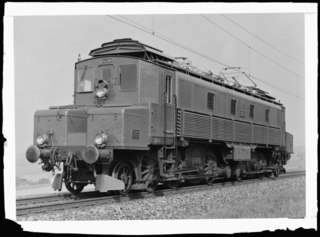
The Ce 6/8 I 14201 was one of four test locomotives ordered by the Schweizerischen Bundesbahnen (SBB) in June 1917. For gaining experience for ordering electrical locomotives this locomotive should – as its three siblings Be 3/5 12201, Be 4/6 12301 and Be 4/6 12302 – have been used for services on the Gotthardbahn. The development of freight locomotives subsequently took a completely different way which was not conceivable at the ordering date. The Ce 6/8I came into service only after the first Ce 6/8II.

The SBB-CFF-FFS Ae 8/14 is a class of electric locomotives built for Swiss Federal Railways to be used on the Gotthard railway. Only three prototype engines were built between 1931 and 1938, each of them in a different design.

The Be 4/6 was a bogie locomotive operated by the Schweizerischen Bundesbahnen (SBB) on the Gotthard Railway along with the Be 3/5, The design was based on the prototype Be 4/6 12302.

The Swiss locomotive class Ae 4/6 was a class of electric locomotives. They were intended as a powerful locomotive for the steep gradients of the Gotthard Railway, but smaller than the huge 'double locomotives' which had previously been tested there. They were built from 1941, during World War II, and although Switzerland remained neutral through this, material shortages led to some quality problems with these locomotives.

The Seebach-Wettingen railway electrification trial (1905-1909) was an important milestone in the development of electric railways. Maschinenfabrik Oerlikon (MFO) demonstrated the suitability of single-phase alternating current at high voltage for long-distance railway operation with the Seebach-Wettingen single-phase alternating current test facility. For this purpose, MFO electrified the 19.45-kilometre-long Swiss Federal Railways (SBB) route from Seebach to Wettingen at its own expense with single-phase alternating current at 15,000 volts.
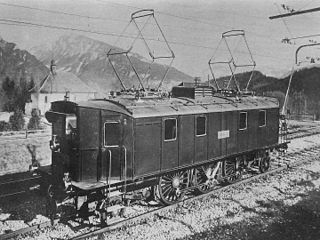
Midi E 3301 was a prototype electric locomotive of Class E 3300 designed for the Chemins de fer du Midi, France. Because of poor performance, it was refused by the Compagnie du Midi and was re-deployed to Swiss railways. On 1 May 1919, it was classified Fb 2/5 11001 and, in 1920, it became experimental locomotive Be 2/5 11001 of the Swiss Federal Railways (SBB).

The Ce 6/6 was an electric locomotive operated by Schweizerischen Bundesbahnen (SBB). Originally ordered from Siemens-Schuckert by Malmbanen in Sweden as Fc 2x3 / 3 in 1912, the locomotive was not delivered due to World War I and was instead bought by SBB in 1919.

The Great Northern Z-1 was a class of ten electric locomotives built for the Great Northern Railway They were used to work the route through the second Cascade Tunnel. They were built between 1926–1928 by Baldwin Locomotive Works, with Westinghouse electrics, and stayed in service until dieselisation in 1956. Each was of 1,830 horsepower (1,360 kW) with a 1-D-1 wheel arrangement, although they were always used in coupled pairs.

Rigid-framed electric locomotives were some of the first generations of electric locomotive design. When these began the traction motors of these early locomotives, particularly with AC motors, were too large and heavy to be mounted directly to the axles and so were carried on the frame. One of the initial simplest wheel arrangements for a mainline electric locomotive, from around 1900, was the 1′C1′ arrangement, in UIC classification.

The Flamatt–Laupen–Gümmenen railway line is a line in Switzerland that was built and formerly operated by the Sense Valley Railway. The 11.5 km-long standard-gauge line on the Flamatt–Laupen–Gümmenen route through the Sense valley was opened on 20 January 1904. The shares of the company were acquired by the Swiss Federal Railways (SBB) and Swiss Post (34 %) in 2001. Since then, the infrastructure of the Sense Valley Railway has been operated by the SBB under contract.





















